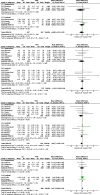Liposomal bupivacaine administration is not superior to traditional periarticular injection for postoperative pain management following total knee arthroplasty: a meta-analysis of randomized controlled trials
- PMID: 36922892
- PMCID: PMC10018851
- DOI: 10.1186/s13018-023-03699-4
Liposomal bupivacaine administration is not superior to traditional periarticular injection for postoperative pain management following total knee arthroplasty: a meta-analysis of randomized controlled trials
Abstract
Background: Liposomal bupivacaine (LB) is a relatively new formulation that slowly releases bupivacaine to extend its efficacy for 72-96 h. It is inconclusive whether LB offers better efficacy than traditional periarticular injection (TPAI) following total knee arthroplasty (TKA).
Methods: Relevant randomized controlled trials (RCTs) were searched using electronic databases, including PubMed, Cochrane Library, EMBASE, and Web of Science. Review Manager 5.4.1 was used for calculations.
Results: Sixteen RCTs were included in this meta-analysis. LB had better effects on morphine consumption equivalents during postoperative 24-48 h than TPAI. No significant difference was observed in pain relief, incidence of nausea and vomiting, or length of hospital stay between the two groups.
Conclusion: LB administration during TKA is not superior to TPAI. Studies with larger sample size are needed to validate our findings. PROSPERO registration number: CRD42022355094.
Keywords: Liposomal bupivacaine; Total knee arthroplasty; Traditional periarticular injection.
© 2023. The Author(s).
Conflict of interest statement
The authors declare that they have no competing interests.
Figures








References
-
- Peters CL, Shirley B, Erickson J. The effect of a new multimodal perioperative anesthetic regimen on postoperative pain, side effects, rehabilitation, and length of hospital stay after total joint arthroplasty. J Arthroplasty. 2006;21(6 Suppl 2):132–138. doi: 10.1016/j.arth.2006.04.017. - DOI - PubMed
Publication types
MeSH terms
Substances
LinkOut - more resources
Full Text Sources
Medical

